Papers by Cynthia Scott-dupree

John Wiley & Sons, Inc. eBooks, May 9, 2014
ABSTRACT Honey bees (Apis mellifera L.) are frequently employed in pesticide toxicity testing eit... more ABSTRACT Honey bees (Apis mellifera L.) are frequently employed in pesticide toxicity testing either as a representative species (i.e., surrogate) for pollinating insects (such as in the European Union (EU)) or in other cases to represent other non-target terrestrial invertebrates. Bees exhibit a wide range of social behaviors, but depending on their interdependency, bees can be broadly divided into two groups: social or solitary. Most of the non-Apis bee toxicity testing conducted in Europe has been on bumble bees, and in particular Bombus terrestris, which is the main species used for commercial pollination. It is clear that non-Apis bees play an important role in supporting diverse plant communities, and an increasingly important role in agriculture. They differ from honey bees in their biological characteristics, which consequently may make them subject to unique exposure routes, as well as unique challenges when it comes to risk management.

Pesticide Risk Assessment for Pollinators, 2014
ABSTRACT This chapter proposes a method for estimating risk to honey bees (Apis mellifera) and no... more ABSTRACT This chapter proposes a method for estimating risk to honey bees (Apis mellifera) and non-Apis bees from pesticides that are applied through sprays (acting on contact) and through seed or soil treatments and tree trunk injections (acting systemically). It describes the risk assessment process for honey bees and non-Apis bees. Problem formulation articulates the intent of the risk assessment and is predicated on particular protection goals for which the regulatory authority is responsible. The chapter illustrates the proposed risk assessment process identified by the participants of the 2011 SETAC Workshop on Pesticide Risk Assessment for Pollinators. The potential risk to adult honey bees from spray applications is assessed through calculation of an HQ. The screening-level and refined risk assessment processes for soil or seed treatment-applied pesticides incorporate different degrees of ecological realism. Screening-level assessments are typically based on conservative assumptions regarding both exposure and effects.

Pesticide Risk Assessment for Pollinators, 2014
ABSTRACT This chapter provides an overview of what to consider when planning or assessing either ... more ABSTRACT This chapter provides an overview of what to consider when planning or assessing either a semi-field or field study for toxicity testing. Elements in the design of semi-field and field studies encompass the study&#39;s objectives, the test organism, a study site, methods, endpoints, sample design, quality assurance and quality control standards, and the statistical analysis of the data. A semi-field study is designed to measure exposure or effects and is performed on a crop that is grown outdoors in an enclosed test system with controlled or confined exposure. A field study is designed to measure exposure or effects and is performed on a crop that is grown outdoors with no enclosure. The chapter describes the semi-field and field study for Apis and Non-Apis Bees. Monitoring schemes, for example, the UK Wildlife Incident Investigation Scheme (WIIS), rely on incidents being reported to a central organization.
Pesticide Risk Assessment for Pollinators, 2014
Frontiers in agronomy, Oct 12, 2022
The Canadian Entomologist, 2014
Halyomorpha halys Stål (Hemiptera: Pentatomidae), the brown marmorated stink bug (BMSB), has been... more Halyomorpha halys Stål (Hemiptera: Pentatomidae), the brown marmorated stink bug (BMSB), has been intercepted numerous times in Canada, and overwintering BMSB adults have been reported by homeowners. However, established breeding populations were not detected before 2012. Here we report the occurrence of established populations of BMSB in southern Ontario, Canada and describe habitats, host plants, and collection efforts from 2012 to 2013. Tracking the phenology and spread of this pest in Ontario is critical for the development of integrated pest management strategies to prevent severe economic damage due to this pest.
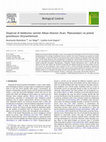
Biological Control, Feb 1, 2010
Dispersal of natural enemies through a crop is a key component of biological control. The release... more Dispersal of natural enemies through a crop is a key component of biological control. The release strategy should optimize the number of predators that are released, the release frequency and number of release sites throughout a crop with regards to the distance that natural enemies can disperse from their release point. In this study, dispersal rate and behaviour of Amblyseius swirskii Athias-Henriot (Acari: Phytoseiidae) was investigated in potted greenhouse chrysanthemums in the presence or absence of prey (Frankliniella occidentalis (Pergande) (Thysanoptera: Thripidae). Results demonstrate that A. swirskii did not disperse far from the release site. Presence of prey did not influence dispersal, but had an effect on predator survival in one experiment. Only a quarter of the A. swirskii eventually attempted to disperse by going down to the ground. The presence of inter-plant contact greatly improved movement of A. swirskii between plants. It is concluded that good coverage with predators of the crop is needed when using A. swirskii in a biological control program. Having a continuous crop canopy will promote dispersal.
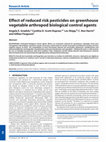
Pest Management Science, Oct 27, 2010
BACKGROUND: Arthropod biological control agents (BCAs) are commonly released for greenhouse veget... more BACKGROUND: Arthropod biological control agents (BCAs) are commonly released for greenhouse vegetable insect pest management. Nevertheless, chemicals remain a necessary control tactic for certain insect pests and diseases and they can have negative impacts on BCAs. The compatibility of some formulated reduced risk insecticides (abamectin, metaflumizone and chlorantraniliprole) and fungicides (myclobutanil, potassium bicarbonate and cyprodinil + fludioxonil) used, or with promise for use, in Canadian greenhouses with Orius insidiosus (Say), Amblyseius swirskii (Athias-Henriot) and Eretmocerus eremicus (Rose & Zolnerovich) was determined through laboratory and greenhouse bioassays. RESULTS: Overall, the insecticides and fungicides were harmless as residues to adult BCAs. However, abamectin was slightly to moderately harmful to O. insidiosus and A. swirskii in laboratory bioassays, whereas metaflumizone was slightly harmful to E. eremicus.

Dose-response, Mar 25, 2014
ᮀ Imidacloprid-induced hormesis in the form of stimulated reproduction has previously been report... more ᮀ Imidacloprid-induced hormesis in the form of stimulated reproduction has previously been reported in green peach aphid, Myzus persicae. Changes in gene expression accompanying this hormetic response have not been previously investigated. In this study, expression of stress response (Hsp60), dispersal (OSD, TOL and ANT), and developmental (FPPS I) genes were examined for two generations during imidacloprid-induced reproductive stimulation in M. persicae. Global DNA methylation was also measured to test the hypothesis that changes in gene expression are heritable. At hormetic concentrations, down-regulation of Hsp60 was followed by up-regulation of this gene in the subsequent generation. Likewise, expression of dispersal-related genes and FPPS I varied with concentration, life stage, and generation. These results indicate that reproductive hormesis in M. persicae is accompanied by a complex transgenerational pattern of up-and down-regulation of genes that likely reflects trade-offs in gene expression and related physiological processes during the phenotypic dose-response. Moreover, DNA methylation in second generation M. persicae occurred at higher doses than in first-generation aphids, suggesting that heritable adaptability to low doses of the stressor might have occurred.
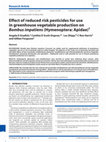
Pest Management Science, 2009
BACKGROUND: Bumble bees [Bombus impatiens (Cresson)] are widely used for supplemental pollination... more BACKGROUND: Bumble bees [Bombus impatiens (Cresson)] are widely used for supplemental pollination of greenhouse vegetables and are at risk of pesticide exposure while foraging. The objective of this study was to determine the lethal and sub-lethal effects of four insecticides (imidacloprid, abamectin, metaflumizone and chlorantraniliprole) and three fungicides (myclobutanil, potassium bicarbonate and cyprodinil + fludioxonil) used or with potential for use in Ontario greenhouse vegetable production to B. impatiens. RESULTS: Imidacloprid, abamectin, and metaflumizone were harmful to worker bees following direct contact, while chlorantraniliprole and all fungicides tested were harmless. Worker bees fed imidacloprid-contaminated pollen had shortened life spans and were unable to produce brood. Worker bees consumed less pollen contaminated with abamectin. Metaflumizone, chlorantraniliprole and all fungicides tested caused no sub-lethal effects in bumble bee micro-colonies. CONCLUSION: We conclude that the new reduced risk insecticides metaflumizone and chlorantraniliprole and the fungicides myclobutanil, potassium bicarbonate and cyprodinil + fludioxonil are safe for greenhouse use in the presence of bumble bees. This information can be used preserve greenhouse pollination programs while maintaining acceptable pest management.
Journal of vegetable crop production, Feb 2, 2004
Changes in pesticide availability require that new compounds be tested for their efficacy in cont... more Changes in pesticide availability require that new compounds be tested for their efficacy in control of pests and pathogens on important vegetable crops. A study was conducted to determine the effectiveness of combinations of the insecticides LORSBAN® 15G (chlorpyrifos), GOVERNOR® 75WP (cyromazine), AZTEC® 2/0.1G (phosetbupirin + cyfluthrin) and REGENT® 80WG (fipronil), and the fungicides PRO-GRO® 30/50D (carbathiin + thiram), DITHANE

Experimental and Applied Acarology, Sep 14, 2013
Biological control in ornamental crops is challenging due to the wide diversity of crops and cult... more Biological control in ornamental crops is challenging due to the wide diversity of crops and cultivars. In this study, we tested the hypothesis that trichome density on different host plants influences the behavior and performance of the predatory mite Amblyseius swirskii Athias-Henriot (Acari: Phytoseiidae). Behavioural observations of this predator in the presence or absence of prey (western flower thrips, Frankliniella occidentalis Pergande) (Thysanoptera: Thripidae) were done on leaf squares of ornamental plant species differing in trichome density (rose, chrysanthemum and gerbera) and compared to a smooth surface (plastic). Tomato leaves were used to observe the influence of glandular trichomes. The performance of A. swirskii was assessed by measuring predation and oviposition rate. Behaviour of A. swirskii was influenced by plant species. Up to a certain density of trichomes, trichome number had a negative effect on walking speed. It was highest on plastic, followed by rose. No differences were found among chrysanthemum, gerbera and tomato. Walking speed was slightly higher on disks without prey. Proportion of time spent walking was the same on leaf disks of all plant species, with and without prey. No effect of glandular trichomes on tomato leaves was seen. Most thrips were killed and consumed on gerbera, and least on rose. Predation rates on chrysanthemum and plastic were intermediate. In contrast, no differences in oviposition rate were found among plant species. The results of this study indicate that trichome density can explain some of the variability in efficacy of A. swirskii on different crops. Release rates of A. swirskii may need to be adjusted depending on the crop in which it is used.
Experimental and Applied Acarology, Dec 12, 2014

Canadian Entomologist, Mar 18, 2019
Halyomorpha halys (Stål) (Hemiptera: Pentatomidae), also known as the brown marmorated stink bug,... more Halyomorpha halys (Stål) (Hemiptera: Pentatomidae), also known as the brown marmorated stink bug, is an invasive agricultural and nuisance pest. Knowledge of the life history of insect pests is important for informing pest management activities. Some North American populations of H. halys have two generations per year, and it is suspected that H. halys may have a partial second generation in the Niagara Region of Ontario, Canada. We determined the number of H. halys generations in Ontario by examining the reproductive development of field-caught adult females. The pattern of reproductive development we observed supports the conclusion that H. halys complete one generation per year in the Niagara Region of Ontario. Reproductively active H. halys were captured as early as May and continued until early September, and the peak of reproductively active individuals occurred between 250 and 550 degree days calculated with a sine-wave function and a lower threshold set to 14.17 °C.
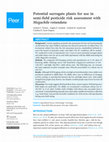
PeerJ, Jan 18, 2019
Background. Current regulatory pesticide risk assessments for bees are based primarily on the hon... more Background. Current regulatory pesticide risk assessments for bees are based primarily on the honey bee (Apis mellifera) and may not always be protective of solitary bees. To incorporate solitary bees into the risk assessment process, standardized methods to assess the hazard of pesticides under semi-field (Tier II) conditions will be needed. We conducted a series of experiments over 2 years to assess potential surrogate plants and adult release rates for use in semi-field experiments with the alfalfa leafcutting bee (ALB, Megachile rotundata). Methods. We compared ALB foraging activity and reproduction on 12 m 2 plots of flowering alfalfa (Medicago sativa) and buckwheat (Fagopyrum esculentum) at low (10♀/20♂) and high (20♀/40♂) adult release rates. The following year, we assessed the same endpoints on plots of purple tansy (Phacelia tanacetifolia) at a release rate of 10♀/15♂. Results. Although ALB foraging activity was high on buckwheat plots, fewer adults were produced compared to alfalfa plots. On alfalfa, there were no differences in foraging activity, nesting, or reproduction between the low and high release rates. ALB readily foraged from purple tansy flowers, but females avoided purple tansy leaves for leaf cell construction. Discussion. Our study suggests that buckwheat alone cannot support ALB during semifield studies on small plots. For alfalfa, we recommend a maximum release rate of 10♀/20♂ in 12 m 2 plots. Further study of higher ALB release rates on purple tansy is warranted. A mixed planting of purple tansy and a plant suitable for leaf piece collection (e.g., buckwheat) may provide favorable conditions for ALB activity and reproduction during semi-field testing.
Pest Management Science, Jan 25, 2017
BACKGROUND This article is protected by copyright. All rights reserved. This article has been acc... more BACKGROUND This article is protected by copyright. All rights reserved. This article has been accepted for publication and undergone full peer review but has not been through the copyediting, typesetting, pagination and proofreading process, which may lead to differences between this version and the Version of Record. Please cite this article as
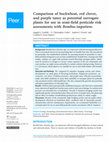
PeerJ, Jul 14, 2016
Background. Bumble bees (Bombus spp.) are important wild and managed pollinators. There is increa... more Background. Bumble bees (Bombus spp.) are important wild and managed pollinators. There is increased interest in incorporating data on bumble bees into risk assessments for pesticides, but standardized methods for assessing hazards of pesticides in semifield and field settings have not yet been established for bumble bees. During semi-field studies, colonies are caged with pesticide-treated flowering surrogate plants, which must be attractive to foragers to ensure colony exposure to the test compound, and must produce an ample nectar and pollen to sustain colonies during testing. However, it is not known which plant(s) are suitable for use in semi-field studies with bumble bees. Materials and Methods. We compared B. impatiens foraging activity and colony development on small plots of flowering buckwheat (Fagopyrum esculentum, var. common), red clover (Trifolium pratense), and purple tansy (Phacelia tanacetifolia) under semi-field conditions to assess their suitability as surrogate plants for pesticide risk assessment studies with bumble bees. We also compared the growth characteristics and input requirements of each plant type. Results. All three plant types generally established and grew well. Red clover and purple tansy experienced significant weed pressure and/or insect pest damage. In contrast, pest pressure was extremely low in buckwheat. Overall, B. impatiens foraging activity was significantly greater on buckwheat plots than red clover or purple tansy, but plant type had no effect on number of individuals produced per colony or colony weight. Discussion. Because of the consistently high foraging activity and successful colony development observed on buckwheat plots, combined with its favourable growth characteristics and low maintenance requirements, we recommend buckwheat as a surrogate plant for use in semi-field pesticide toxicity assessments with B. impatiens.
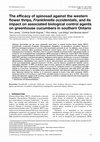
Pest Management Science, 2005
Insecticides are the most commonly used tactic to control western flower thrips (WFT), Franklinie... more Insecticides are the most commonly used tactic to control western flower thrips (WFT), Frankliniella occidentalis Pergande (Thysanoptera: Thripidae), on greenhouse cucumber. However, WFT has developed resistance to several of the insecticides presently in use. In addition, some of these insecticides adversely affect greenhouse biological control agents used to control WFT, resulting in subsequent pest resurgence. Therefore, there is a need to identify novel insecticides with unique modes of action for use in integrated pest management (IPM) programs to effectively control WFT with minimal impact on associated biological control agents. In laboratory bioassays conducted in 2001, immature and adult WFT and three associated greenhouse biological control agents: Amblyseius cucumeris Oudemans (Acarina: Phytoseiidae), Orius insidiosus Say (Hemiptera: Anthocoridae) and Encarsia formosa Gahan (Hymenoptera: Aphelinidae) were exposed to direct, direct/residual, and residual contact applications of the novel biopesticide, spinosad (Conserve 120 SC), and the industry standard for whitefly control, endosulfan (Thiodan 50 WP). In all three types of assay, spinosad was effective against immature and adult WFT life stages. It showed low toxicity to A cucumeris, moderate toxicity to O insidiosus and high toxicity to E formosa. Greenhouse studies involving exposure of immature and adult WFT and adult biological control agents to cucumber leaves sprayed previously with spinosad supported the laboratory data. Spinosad showed low toxicity to A cucumeris exposed to leaves 1 day after treatment (DAT), moderate toxicity to O insidiosus 1 and 8 DAT, and high toxicity to E formosa up to 28 DAT. These data, along with spinosad's unique mode of action, suggest it would be a valuable reduced-risk control agent for greenhouse cucumber IPM programs.
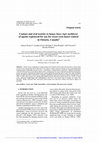
Apidologie, Oct 1, 2005
Assays were conducted to compare direct and residual contact and oral toxicities to honey bees of... more Assays were conducted to compare direct and residual contact and oral toxicities to honey bees of sweet corn insecticides and of Bt-sweet corn. Direct contact assays focusing on LC 50 determined that technical grade clothianidin was most toxic, > carbofuran, > imidacloprid = spinosad, > lambda-cyhalothrin, > Bacillus thuringiensis. In residual contact assays, forager age bees were exposed to treated non-transgenic sweet corn tassels. Carbofuran treated tassels caused significant mortality up to 2 and 3 days after treatment (DAT) in 2002 and 2003, respectively. Lambda-cyhalothrin treated tassels had no impact on honey bees in 2002; in 2003, their toxicity was significantly higher than the untreated control tassels for 1 DAT. In both years, spinosad, imidacloprid and clothianidin or Bt-sweet corn tassels had no impact on honey bee mortality. Pollen collected from insecticide field treated corn and fed to honey bees had no impact on mortality. Apis mellifera / sweet corn / foliar insecticides / seed treatment / Bt-sweet corn / toxicity









Uploads
Papers by Cynthia Scott-dupree